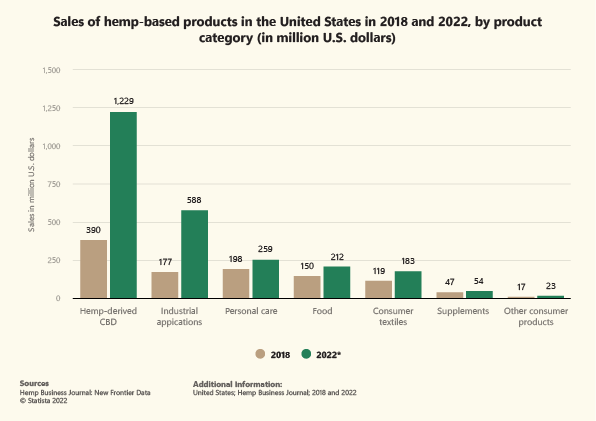
Hemp has been used industrially for thousands of years in the manufacturing of rope, clothing, furniture, and so many other things. It is a unique material because it’s naturally antibacterial, durable, water resistant, and you don’t need to use pesticides for it to grow well. There are so many things about hemp that make it an amazing industrial resource, but there is a lot of stigma surrounding it because of its relation to marijuana. Fortunately, many companies and nations around the world are overcoming their biases, and the hemp industry is gathering momentum. It is so important to understand the real facts about hemp and where it will be in future years, so we can monitor it. To help you with that, here are some important hemp stats and figures.
General Hemp Stats
Hemp is a plant related to marijuana, with a few different varieties that grow differently and are used for different purposes. Here are some statistics to help us understand the basics:
- To be legally considered industrial hemp, the plant must be grown and harvested with less than .3% THC (Tetrahydrocannabinol). THC is the “drug” part of marijuana.
- The four main varieties of hemp, according to the USDA, are floral, grain, fiber, and seed.
Floral Hemp

Floral hemp describes plants that are cultivated specifically for the flower, which is used in a lot of skincare and personal hygiene products. Here's the rundown:
- 19.7 million pounds of floral hemp are harvested in the US every year, as of 2021.
- 16,000 acres of American land is dedicated to the growth and research of floral hemp.
- About 1,235 pounds of floral hemp is harvested per acre of land planted.
- The floral hemp economy is valued at $623 million.
Grain Hemp
Grain hemp is one of the smaller varieties of the hemp plant. It is often used in food, for humans and other animals. Want the details?
- Grain hemp can grow to be anywhere from 4-6 feet tall when it’s harvested.
- 4.37 million pounds of grain hemp was harvested in the United States in 2021.
- The United States has 8,255 acres dedicated to growing grain hemp.
- 530 pounds of grain hemp can be harvested per acre of land.
- The grain hemp economy is worth 599 million dollars in the United States.
Fiber Hemp
Fiber hemp is very useful for a variety of different industries. It’s used to make clothes (including hemp shoes!), paper, and rope among other things. Let’s take a closer look:
- Fiber hemp is the tallest of the hemp varieties, sometimes growing to be over 14 feet tall!
- 33.2 million pounds of fiber hemp was produced in 2021 throughout the USA.
- 12,700 acres of land is used for growing fiber hemp and researching it’s uses.
- Because it grows so close together, 2,620 pounds of fiber hemp comes out of every acre of land harvested.
- The fiber hemp market is worth $41.4 million.
Seed Hemp
Seed hemp is used as an ingredient in many natural products, especially dairy. It can also be used in essential oils. What do you need to know?
- The open production of hemp in the United States equals 1.86 million pounds.
- 3,515 acres of land across the US are used for growing and cultivating seed hemp.
- 530 pounds of seed hemp is harvested from an acre of land.
- The seed hemp market was valued at $41.5 million during the 2021 season.
Hemp Product Stats

Hemp is gaining popularity in many industries because it’s a more sustainable version of old-fashioned materials. For example, hemp is slowly replacing trees in the production of paper because it grows faster, so it’s a more replenishable resource. Hemp also competes with cotton in the clothing industry as experts argue which material is best. Here are the stats:
- There are 20 main commercial hemp product applications in the United States, including but not limited to textiles, animal feed, and paper.
- The hemp seeds product segment has a Compound Annual Growth Rate (CAGR) of 20%, the fastest of all the segments. Hemp seeds are used as healthier substitutes in food for human and animal consumption.
- Hemp grows faster and closer together than regular trees do, so it can produce 2-4 times the amount of paper annually.
- Industrial hemp needs less than 10% of the amount of water than industrial cotton does to grow.
- Hemp is four times stronger than industrial cotton.
- Hemp produces 3x the amount of fiber per acre than cotton does (generally 1500lbs to 500lbs) and grows quicker by 1-2 months.
Hemp Stats for the U.S.A.
The United States has passed several bills in recent years allowing for the growing of hemp and research about its properties. The US is unique because every state has the chance to make its own laws and regulations regarding hemp. What’s going on with hemp nationally right now?

- The United States is the world’s 3rd largest hemp producer in the world.
- In 2021, all of the open-grown protected hemp in the United States combined was valued at $824 million.
- In 2021, 54,200 acres of land in the United States were dedicated to growing hemp for all purposes.
- The current US hemp industry includes more than 9,358 companies with 60,606 paid employees.
- 47 states in the US have proposed and passed legislation for the research or distribution of hemp-based products.
- There was a huge hemp boom in the US in 2018 because the Farm Bill was passed. 78,176 acres of hemp were planted in 23 states for industry and research.
Global Hemp Stats
Hemp actually made its debut in modern manufacturing in Asia. It’s spread over the years, and now hemp is grown in various amounts on every continent. What are the world stats?

- Although hemp seed is the fastest-growing segment in America, the textile segment of industrial hemp production is the largest globally and accounts for 24% of revenue worldwide.
- The Asia Pacific area has the world’s largest producers of hemp, bringing in 32% of the global revenue by themselves.
- The hemp fiber market was measured at $7.91 billion this year (2022). It is expected to continue growth with a CAGR of 39.7% and reach $26.41 billion by 2026.
- China wants to plant 3.2 million hectares of hemp fiber by 2030 to support the hemp textile industry.
- France is the largest producer of hemp in Europe. More than 50% of the hemp produced in Europe in the past three decades has come from France.
Hemp Stats During the Pandemic
The COVID-19 pandemic affected markets in all economic sectors, and hemp was no different. Although nothing crashed, growth was seriously stilted and farmers struggled to make ends meet. How exactly were the numbers affected?
- The yearly number of acres licensed to grow hemp dropped by more than 80%, from 580,000 to just over 100,000.
- One-third of farmers in Kentucky had licenses only to store hemp because no one was buying it or planting it anymore.
- The growth rate of space licensed to produce industrial hemp was also way down, with only 3,800 acres being cleared in 2021.
Get Your Premium Hemp Shoes with 8000Kicks

At 8000Kicks, we are proud to be a part of the hemp textile market, providing you with high-quality shoes that are sustainable and stylish. We look forward to watching the hemp market grow and change, and to helping it along the way with our pioneering methods. Get your 8000Kicks hemp shoes today!
Sources:
- https://www.statista.com/statistics/980325/hemp-based-products-sales-us/
- https://www.grandviewresearch.com/industry-analysis/industrial-hemp-market
- https://downloads.usda.library.cornell.edu/usda-esmis/files/gf06h2430/xd07hw825/v692v917t/hempan22.pdf
- https://www.ibisworld.com/united-states/market-research-reports/industrial-hemp-production-industry/
- https://www.canada.ca/en/health-canada/services/drugs-medication/cannabis/producing-selling-hemp/about-hemp-canada-hemp-industry/statistics-reports-fact-sheets-hemp.html
- https://www.alliedmarketresearch.com/industrial-hemp-market-A08684
- https://tealfeed.com/usa-organic-hemp-market-statistics-2023-ufeit
- https://www.thebusinessresearchcompany.com/report/hemp-fiber-global-market-report
- https://www.farmers.gov/your-business/row-crops/hemp
- https://stateline.org/2021/07/09/the-hemp-boom-is-over-what-now/
- https://blog.signature-products.com/hemp-around-the-world/
- https://www.ravenox.com/blogs/news/hemp-rope-vs-cotton-ropes#:~:text=Hemp%20plant%20roots%20aerate%20the,only%20500%20pounds%20per%20acre!
- https://stridewise.com/hemp-vs-cotton/#:~:text=Hemp%20Fabric%20vs%20Organic%20Cotton,-Hemp%20is%204&text=Hemp%20fabric%20is%20four%20times,the%20elements%2C%20hemp%20is%20it.
- https://www.usda.gov/media/blog/2022/02/24/floral-hemp-field-and-greenhouse-cbd
- https://hempfoundation.net/what-are-the-top-five-uses-of-hemp-fiber/
